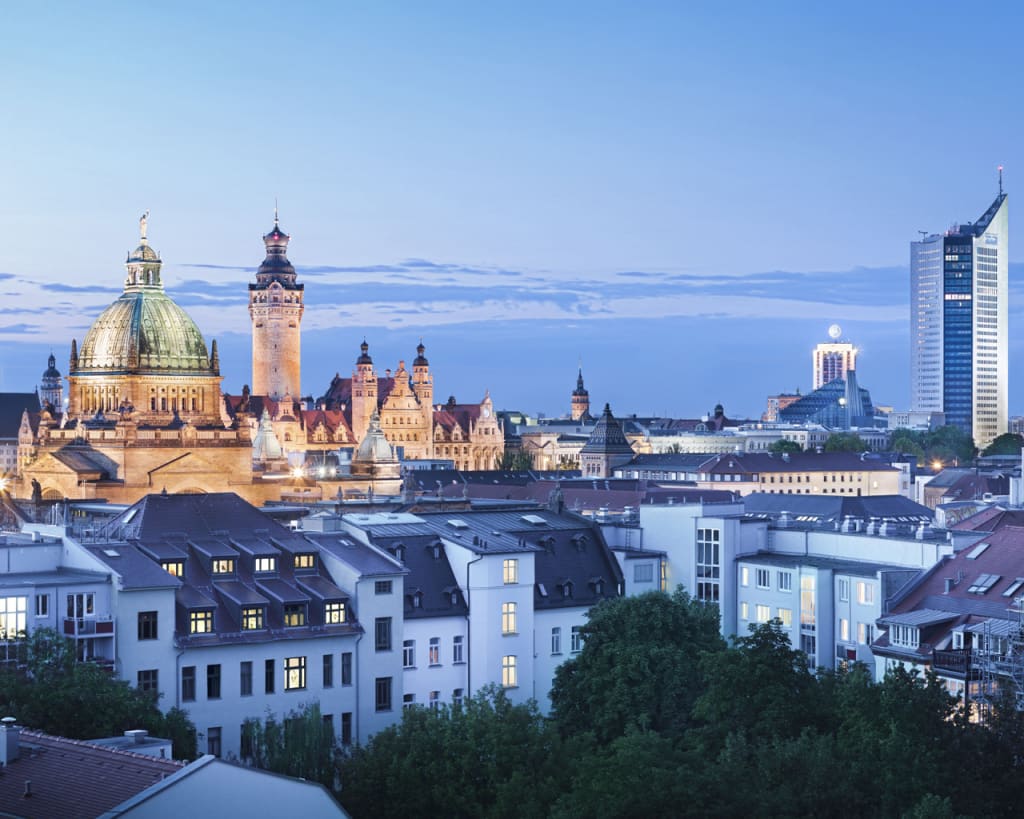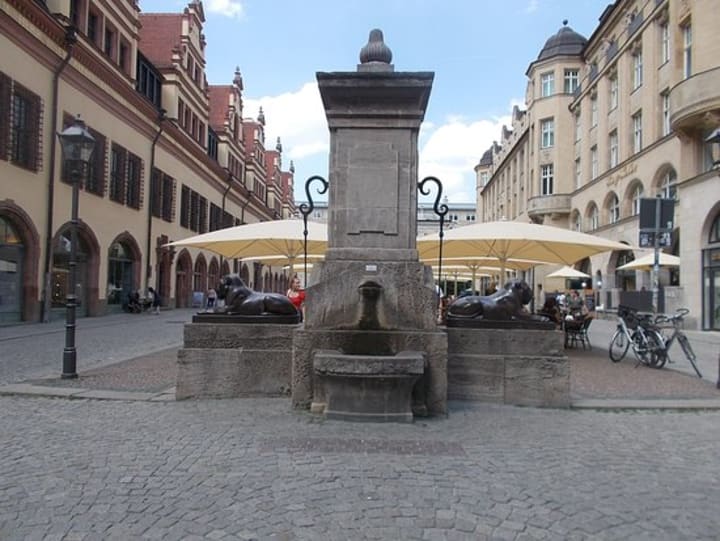
Leipzig is a vibrant, dynamic city and for hundreds of years an important European center. It is also known as a musical city, a trade fair mecca, and a city of books. Residents of this city have included famous poets such as Lessing, Klopstock, Gottsched, and Goethe. The thinking of the city has been influenced by philosophers like Liebniz, Nietzsche, and Bloch. It also has music in its history through the musical works of Bach and Mendelssohn.

The Church of St. Nicholas was built in the Romanesque and Gothic styles. It has a neo-Classical interior with palm-like pillars and cream-colored pews. This church is famous for playing a key role in the nonviolent movement which led to the downfall of the East German Government. In 1982 the church was host to “peace prayers” every Monday at 5 PM. These prayers empowered and inspired residents to confront the injustices plaguing their country. Beginning with September 1989 the prayers were followed by candlelight demonstrations, peaking on October 9 when 70,000 citizens took to the streets. Finally, the GDR leadership capitulated. A palm-topped column stands outside of the church to commemorate this peaceful revolution.

The Fine Arts Museum is housed in an impressive building a modernist glass cube. It features a world-class collection of paintings from the 15th century to today among them the artwork of Caspar David Friedrich, Cranach, Munch, and Monet. The highlights here are rooms dedicated to German artists Max Beckmann, Max Kinger, and Neo Rauch. Exhibitions range from sculpture and installation to religious art.

The huge square Augustuplatz is surrounded by some of the city’s most famous buildings. On the western side is the 11-story Kroch Haus, one of Leipzig’s first high-rises topped by a clock. Impressive are the glass-fronted Paulinum, the university church, and the new campus building. It is the creation of Dutch architect Erick van Egeraat.

At the Augustuplatz you’ll find the Mende Fountain in front of the Concert hall. This is the largest fountain in Leipzig and cost 189,000 gold marks to build. It is the creation of Adolf Gnauth. A merchant’s widow, Pauline Mende bequeathed her money to build the fountain and it was named for her.

During the time of the German Democratic Republic or GDR, all walls seemed to have ears. There is an exhibit documenting the doings of the GDR located in the former Leipzig headquarters of the East German secret police or the Stasi. The building is known as the Runde Ecke or Round Corner. English auto guides are available for the all-German displays on propaganda, preposterous disguises, surveillance devices, recruitment, scent storage, and other most chilling machinations revealing the world of the GDR.

In the epic 1813 battle that led to the decisive victory of Prussian, Austrian, and Russian forces over Napoleon’s army, half a million soldiers fought and were killed. A century later the Monument to the Battle of the Nations was built near the fields of battle. This is a 91- meter colossus offering spectacular views from the top. Within the monument complex is the integrated Forum 1813 exhibit which tells the history of it all.

The motto of the Alte Spinnerei, a 19th-century cotton-spinning factory turned into an artist colony is “cotton to culture”. In this huge red-brick building about 80 New Leipzig School artists including Neo Rauch, have their studios. You’ll also find the creations of designers, architects, goldsmiths, and other creative people displayed in 10 galleries.

At the Thomaskirche, Johann Sebastian Bach worked as a cantor from 1723 until he died in 1750. After his death, he was laid to rest beneath a bronze plate in front of the altar. The Thomas choir, once led by Bach, has been singing since 1212 and today includes 100 boys ages eight to eighteen. You can hear the marvelous music of Bach on the church’s giant organ and you can climb up the church tower.

Felix Mendelssohn-Bartholdy, a key figure of the Romantic age, was appointed music director of the Leipzig Gewandhaus Orchestra in 1835 and held that position until his sudden death at the age of 38. At the Mendelssohn House, you can learn more about him in the Biedermeier-furnished apartment where he lived with his family. Frequent evening recitals of Mendelssohn’s work are played here.

Visitors can learn about the city’s history from its beginning as a medieval trading town to the present including the Battle of Nations and the 1989 peaceful revolution at the Renaissance-style Town Hall. At the nearby modern extension, the Neubau temporary exhibitions are held.
At the back of the Old Town Hall is the Naschmarkt where you can find the Old Stock Exchange with its grand staircase, a statue of the student Goethe, and the Lowenbrunnen or Lion Fountain.

The fountain dates back to 1690 and can be reached by three steps which surround it and it’s decorated with mythical creatures and marine sandstone reliefs. Around 1820 there was a decorated pump handle in the form of an iron lion, designed by Berlin sculptor Johann Gottfried Schadow and cast by Lauchhammert. On the back of the fountain is a Versalienschrift on the back of the fountain that reads “In the last war in 1918, this fountain in the shape of the old wooden housing has been rebuilt from the rate by the architect Dr. Ing. Hugo Lucht.

The highlight attraction at the Leipzig Zoo is Gondwanaland, a jungle wonderland of 17,000 plants and 300 exotic animals.

Visitors can see rare and endangered species like Komodo dragons and pigmy hippos roaming about in enclosures in a climate-controlled hall among fragrant tropical plants. You can explore by following a jungle path, a treetop trail, or drifting along in a boat.

Asisi Panometer is a combination of a panorama (giant 360-degree painting) and a gasometer (giant gas tank). This concept is the idea of Berlin-based artist Yadegar Asisi. He used paper, pencil, and computer technology to create amazingly detailed monumental scenes drawn from nature or history. Each artwork is around 100 meters long and 30 meters high.

The neo-Baroque Neues Rathaus counts as one of the world’s largest town halls. It has 600 rooms and an impressive 108-meter-high tower. The building dates back to the 16th century with updates done in 1905. Its restored interior makes this one of the finest municipal buildings in Germany.

The Bach Museum is an interactive museum telling visitors about the life and accomplishments of Johann Sebastian Bach. Visitors can learn how to date a Bach manuscript, listen to Baroque instruments, and listen to his compositions. In the “treasure room” downstairs are displays of rare original manuscripts.

Leipzig University was founded in 1409 and is one of the oldest universities in Germany. It is an interdisciplinary, international comprehensive university. To become a European top-level university and internationally recognized seat of research and learning the university draws on an extensive range of subjects. It crosses the boundaries of traditional academic disciplines with some of its traditions being international collaboration and networking with non-university research institutes. Leipzig University consists of 14 faculties with 128 institutes. At the university 35,000 people research, teach, and study and over 4,300 people are employed at the University Hospital of Leipzig.

Right next to the university is the Botanical Garden dating back to the 16th century. This is the oldest botanical garden in Germany and among the oldest in the world. Visitors can see 7000 plant species from around the world.

Located south of Leipzig is the Cospudener See. This lake was formed on the site of a former open-cast mine. It has become popular with residents with long stretches of sand beaches and a sauna.

Housed in the newly renovated Grassi Museum is the Museum of Musical Instruments. It is close to the city center and opened for the first time on May 30th, 1929. From the very beginning, the museum has been part of Leipzig University. The museum features such valuable treasures as the portrait of Heinrich Schutz and the world’s oldest originally preserved pianoforte built in 1726 by the inventor of the hammer mechanism Bartolomeo Cristofori. Visitors get to explore six centuries of Leipzig music history and see many different kinds of musical instruments.

A restful place on the outskirts of Leipzig with over 100 acres is Agra Park. The park offers people the opportunity to relax, stroll, and picnic. Lots of trade fairs and exhibitions also take place here in the Park’s outbuildings and halls. Lots of plants and trees to enjoy.

Right in the heart of Leipzig is Auenwald Park offering many recreational activities. There are trails and pathways for walking, jogging, and even woodland walks. People just love the large lake area where they can see local wildlife.
About the Creator
Rasma Raisters
My passions are writing and creating poetry. I write for several sites online and have four themed blogs on Wordpress. Please follow me on Twitter.






Comments
There are no comments for this story
Be the first to respond and start the conversation.